Part X: Films Co-directed by Edwin S. Porter & J. Searle Dawley
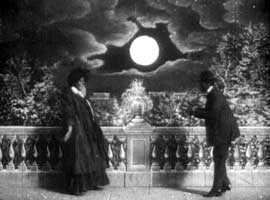 Bertha Regustus stars as Mandy in the surprising comedy Laughing Gas (1907). Surprising because the star is African American & yet nothing about the film requires that she be so. No stereotypes are dragged out, it's just a wonderful comic performance. Bertha Regustus stars as Mandy in the surprising comedy Laughing Gas (1907). Surprising because the star is African American & yet nothing about the film requires that she be so. No stereotypes are dragged out, it's just a wonderful comic performance.
Although incomplete, nine minutes remains of Laughing Gas. A woman visits a dentist which involves her getting a big dose of laughing gas. As a "facial expression film" she goes from a swollen jaw & look of agony, to a much happier condition, unable to stop laughing.
The dentist pulls out an absurdly big tooth as his patient laughs so hard she falls out of the dentist chair. Her laughter is so broad & infectious that the dentist & his assistant are soon afflicted by uncontrolable laughter. Even after she leaves, the two men are staggering about the room unable to contain themselves.
Mandy heads off on the subway where tramps & elegantly dressed people brush shoulders. She's still caught in the thros of laughter & soon everyone on the train -- tramps, businessmen, ladies, a conductor -- are in stitches.
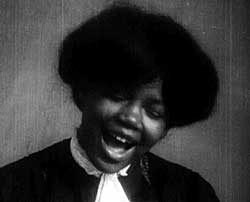 When she encounters a street vendor holding a tray of chestnuts or candies (it's not clear what he's selling) her laughter gets him laughing so hard he drops his wares. When she encounters a street vendor holding a tray of chestnuts or candies (it's not clear what he's selling) her laughter gets him laughing so hard he drops his wares.
The to-do leads to them both being dragged into the police station to explain themselves, but Mandy can only keep laughing, which quickly gets the police laughing too. When they decide to let her go, they're still laughing when she's gone.
Next up are a couple rough laborers in the street about to have a fight until Mandy cures their anger just by passing by full of laughter.
She works as a maid for a wealthy white family & when serving them their dinner, she laughs so hard she spills food on them, but they don't mind, as they're laughing so hard they fall on the floor.
On her way to a midnight church meeting, she encounters a young dandy on a bridge (this comedian was billed as "Mr. La Montte"). Her laughter gets him laughing so hard she has to give him a good shaking to help him regain his balance.
When she reaches the church, there's a serious sermon going on, but very soon the entire congregation is laughing hysterically & the minister is clutching a stitch in his side.
The film closes with more facial expressions of Mandy laughing & laughing. She's a gorgeous good looking woman of amazon height, absolutely a wonder to see laugh. I can't help but assume this film made her famous & that Bertha Regustus became thereby the first black movie star in America.
And I have to assume this role was written specifically for her because the filmmakers found her naturally a joyful personality they hoped they could capture on film, which they certainly did.
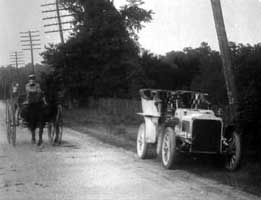 Chollie & Gawge (i.e., Charlie & George) are the title characters of The Rivals (1907). Both men are competing for the same young lady's hand.
Chollie & Gawge (i.e., Charlie & George) are the title characters of The Rivals (1907). Both men are competing for the same young lady's hand.
The rivals are based on the characters of Cholly & Gawge from the Sunday funnies, comic strip characters by T. E. Powers, a name of some conseqquence among cartoonists of the day, & signal to early cinema as well, including animation.
Chollie messes with Gawge's automobile. When it won't run, Chollie happens by with a horse-drawn carriage & takes the girl away, leaving Gawge with his best clothes ruined by grease from the horseless carriage.
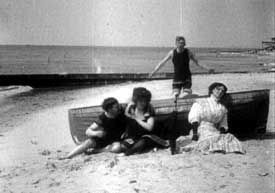 In tit for tat revenge, Gawge gives Chollie some nice cigars & Chollie in turn shares one with the girl's father. Since they are of course explosive, Gawge is able to get the girl that day. In tit for tat revenge, Gawge gives Chollie some nice cigars & Chollie in turn shares one with the girl's father. Since they are of course explosive, Gawge is able to get the girl that day.
This continues through additional scenarios, including one making the other look like a baby kidnapper, faking a ghost & a dragon, & causing one's rival to be caught cheating on their mutual girlfriend. The dragon's rather attractive.
At thirteen minutes it surprisingly enough gets a bit long to sustain a single joke, but it regains momentum toward the climax with a comic duel by pistols & the minor pay-off when the foolish rivals lose the girl to a third man.
With many outdoor sets it's a visually attractive comedy with the locations around the city very appealing.
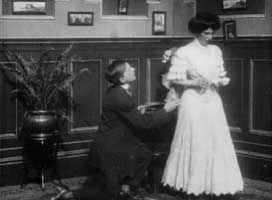 A young man's proposal of marriage is at first turned down but then accepted by his girlfriend, at the start of the eleven minute comedy College Chums (1907). It is very loosely based based on the popular play Charley's Aunt by Brandon Thomas. A young man's proposal of marriage is at first turned down but then accepted by his girlfriend, at the start of the eleven minute comedy College Chums (1907). It is very loosely based based on the popular play Charley's Aunt by Brandon Thomas.
In its day this was a "talkie" of sorts, in that live actors would be placed behind the screen to speak the comic dialogue. Fortunely the story is simple & obvious so that it works just as well as a silent film, & incorporates quite a novel method of showing dialogue visually.
The young lady soon sees her fiance strolling in the park with another woman. She calls him on the phone, very angry. We see cameos of the couple on their respective phones, & the cameos are floating above a painting of the city.
Words stream out of the phone & flutter across the sky to the other phone, then the reply flutters back across the sky. The young man claims rather stammeringly that the girl was his sister, an obvious lie.
His fiance is coming over to meet this alleged "sister," so our carousing hero convinces his college chum to disguise himself as a girl. The fact that they had a wig handy seems suspiciously gay.
His girlfriend & her mother come over in a huff, relieved to find there is in fact a sister. When the transvestite & the father are alone, however, comedy seduction ensues first with the father then with the girlfriend, the bisexual implications of the happy crossdresser being very overt.
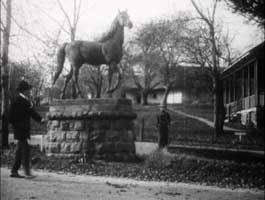 The Trainer's Daughter (1907) is an action film set in the stables of a race track.
The Trainer's Daughter (1907) is an action film set in the stables of a race track.
It's not quite complete, but enough so that it looks improbable that anyone could've followed the story even in its entirety, except that the plot would be described beforehand for the audience, or dialogue would be spoken by live actors behind the screen.
A race fixer intends to sabotage the best jockey's horse. But the jockey overheard the plan & attempted to stop it. In the ensuing fight he's knocked unconscious.
The villains carry his limp body to a disused storage barn, knowing that without the jockey the best horse won't have a rider for the next race.
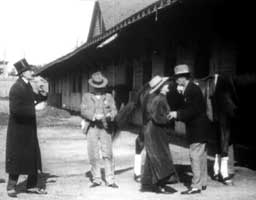 The jockey wakes up dazed in a disused barn & heads back toward the stable. Even if he makes it in time, he's in no condition to ride. The jockey wakes up dazed in a disused barn & heads back toward the stable. Even if he makes it in time, he's in no condition to ride.
Meanwhile a love triangle has developed between the horse trainer's daughter & two men. Her family doesn't think the man she prefers is good enough for her, but she dislikes the man her family hopes she will marry.
The injured jockey turns up in time to reveal that it is the suitor disliked by the trainer's daughter who is in fact the villainous fixer.
The trainer's daughter takes the place of the injured youth, disguising herself as a jockey. The race will come down to her father's horse ridden by herself, vs the horse of the fixer ridden by his jockey.
In this precursor to National Velvet (1944), it will be the girl jockey who wins, & of course the unwanted suitor for her hand will be forever out of the picture.
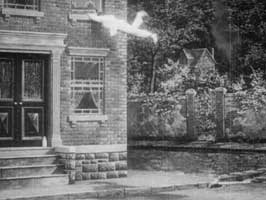 A Suburbanite's Ingenius Alarm (1908) is an incomplete film partially restored with still photos & contemporary discriptions. What we now have is seven minutes of a comedy short that likely ran eleven to fourteen minutes originally.
A Suburbanite's Ingenius Alarm (1908) is an incomplete film partially restored with still photos & contemporary discriptions. What we now have is seven minutes of a comedy short that likely ran eleven to fourteen minutes originally.
Mr. Early, who is habitually late for work & at risk of losing his job, has a plan that will help him get up early enough to make it to work. He has tied a rope to his ankle & hung it out from his second floor bedroom window. When his fellow office worker is walking to the office, he has agreed to pull on the rope to make sure Mr. Early wakes up.
But a thief sees the rope hanging from the window. He was about to try to climb up when a policeman spots him. The thief runs off, & the officer tries to pull the rope loose, dragging Mr. Early out of bed.
Not giving up on his idea, he explains it to the cop, then returns to bed with the rope still dangling. A drunk staggers by the apartment house & hangs on the rope until Mr. Early appears at the window & douses him with water.
When the milkman is delivering milk, the vengeful drunk ties the rope to the bumper of the horse-drawn milk cart. Mr. Early is dragged out of bed, across the floor, out the window, & down the street.
A long dragging sequence proceeds, the milkman being apparently deaf to the yells. At last a police officer stops the milk cart. Mr. Early shows up first at work, with crutch & arm in a sling.
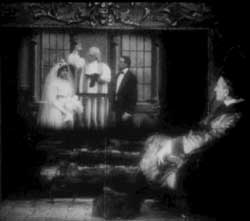 A tragic melodrama, Fireside Reminiscences (1908) survives in pretty beat-up condition.
A tragic melodrama, Fireside Reminiscences (1908) survives in pretty beat-up condition.
A wealthy but foolish man casts out his wife because he caught her in the arms of another man, not giving her the chance to explain the man was her brother.
Three years later he is still living a life of loneliness, & his daughter has this whole while been without a mother. Sitting by the fireplace, he begins to envision his wife in the flames.
He envisions their former life together, meeting, marrying, raising their daughter. But he also remembers her in the arms of another man, his tossing her out, & more, he imagines the things he had never personally witnessed: her miserable wanderings in a wintery world.
In fact she is outside her past home at that very moment, having collapsed in the snow. Her husband brings her in, & they are reconciled after she begs & begs & begs; although, considering his error, it was he who should have been begging forgiveness.
Only with the intervention of their little girl does the husband forgive the wife for something she never did.
If one of Porter's films had to fall into such ruinous shape, it's just as well it was this one. It's too much a dumb soap to be entertaining as a story, & too badly damaged to be visually rewarding.
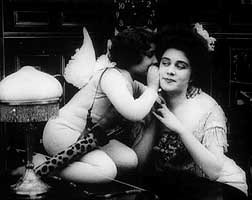 Intended as a film for release on Valentine's Day in 1908, Porter had gotten notorious for going over schedule, & did not finish the ten-minute Cupid's Pranks (1908) in a timely manner.
Intended as a film for release on Valentine's Day in 1908, Porter had gotten notorious for going over schedule, & did not finish the ten-minute Cupid's Pranks (1908) in a timely manner.
The slowness of the production schedule at the Edison film company had become a major problem in a rapidly changing industry.
New film studios were making films hand over fist & projection nickelodians were changing their scheduled programs as often as daily. But Porter still operated on old methods established when films would be shown in kinetoscope peep-boxes until they wore out.
Cupid's Pranks begins with a classic image of the young winged Cupid whispering in the ear of Venus. We then see Cupid in a cavern forging love-arrows. He falls asleep near the forge when Jupiter stops by & gives the kid a spanking for sleeping on the job.
Jupiter then gives the kid a lecture on the responsibilities of the gods & sends him off to shoot a few arrows.
A very bad special effect shows a horizontally split screen, the flying Cupid on the upper portion, the countryside passing by below him. The same effect is used in other films, including A Twentieth Century Tramp: Happy Hooligan & His Airship (1902).
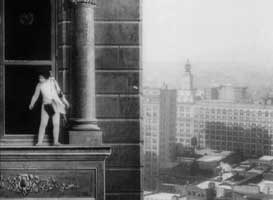 A much better effect with horizontal split screen shows Cupid standing on the ledge of a New York brownstone (really a stage set) with the right side of the screen showing the actual bustling city. With binoculars, Cupid is scoping out his next targets. Wearing a bodysock, the kid playing Cupid looks practically naked. A much better effect with horizontal split screen shows Cupid standing on the ledge of a New York brownstone (really a stage set) with the right side of the screen showing the actual bustling city. With binoculars, Cupid is scoping out his next targets. Wearing a bodysock, the kid playing Cupid looks practically naked.
Taking his time selecting a victim, Cupid flies into an upscale dancehall & the one woman without a dance partner sees him & begs him to arrange for her a romance. He shoots her with his arrow, then lassoes a partner for her. It's not really a "prank" as promised, but pure matchmaking, & Cupid's quite proud of his success.
Cupid hitches a ride in the automobile in which the young couple is being transported. He arranges for the car to break down in order to keep the lovebirds together a good while longer. When they are conversing at the yhoung woman's home, Cupid turns the clock backward so they won't soon part.
But unexpectedly they have an argument & as the gentleman storms out, he steps on Cupid's foot. Cupid hops about distressed. Finding a crutch & a bandage for his head, he hobbles off in pursuit of the angry gentleman.
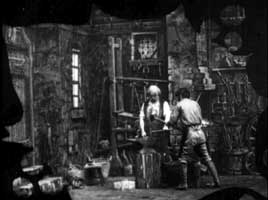 A minute & a half fragment survives of Tale the Autumn Leaves Told (1908).
A minute & a half fragment survives of Tale the Autumn Leaves Told (1908).
It's a complete scene & tells a pretty clear story by itself, as Porter always had a habit of constructing his "longer" films in complete parts, a hold-over from his days of making two-minute films for mutoscope, when even for longer films some exhibitors would obtain only parts.
The scene is a blacksmith shop in Scotland. The smithy & his apprentice are at work when in come a couple who wish to marry, & behind them a Scottish soldier as witness.
The smithy is apparently a minister as well. He gives the young man & woman their vows of marriage & has the apprentice & the soldier sign the registry as witnesses.
That's when another man rushes in, apprently the disapproving father, but is shown the deed is done, the couple are already married. At first angry, he turns pragmatic & welcomes the young man into the family.
A peculiar cut-out shape can be detected around this scene. It doesn't look much like a leaf shape but that's what it is. The scenes leading up to this happy ending are lost, but discriptions survive, & each scene was viewed through a different leaf-shaped cut-out frame.
Return to Part 1:
Kinetoscope Films of Edwin S. Porter
copyright © by Paghat the Ratgirl
|
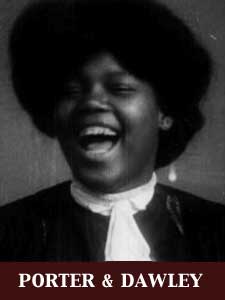

 When she encounters a street vendor holding a tray of chestnuts or candies (it's not clear what he's selling) her laughter gets him laughing so hard he drops his wares.
When she encounters a street vendor holding a tray of chestnuts or candies (it's not clear what he's selling) her laughter gets him laughing so hard he drops his wares.
 In tit for tat revenge, Gawge gives Chollie some nice cigars & Chollie in turn shares one with the girl's father. Since they are of course explosive, Gawge is able to get the girl that day.
In tit for tat revenge, Gawge gives Chollie some nice cigars & Chollie in turn shares one with the girl's father. Since they are of course explosive, Gawge is able to get the girl that day.

 The jockey wakes up dazed in a disused barn & heads back toward the stable. Even if he makes it in time, he's in no condition to ride.
The jockey wakes up dazed in a disused barn & heads back toward the stable. Even if he makes it in time, he's in no condition to ride.


 A much better effect with horizontal split screen shows Cupid standing on the ledge of a New York brownstone (really a stage set) with the right side of the screen showing the actual bustling city. With binoculars, Cupid is scoping out his next targets. Wearing a bodysock, the kid playing Cupid looks practically naked.
A much better effect with horizontal split screen shows Cupid standing on the ledge of a New York brownstone (really a stage set) with the right side of the screen showing the actual bustling city. With binoculars, Cupid is scoping out his next targets. Wearing a bodysock, the kid playing Cupid looks practically naked.